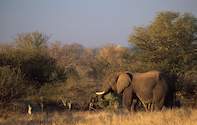
Mpumalanga to Host Conservancy Conference
The role of private landowners in nature conservation is becoming increasingly important, and many owners are uniting their land for the better good of nature in the form of conservancies. Mpumalanga has been selected to host the annual national conference of the National Association of Conservancies of South Africa (NACSA) from April 30 to May 1, 2005.
"More than one million hectares of land are included in conservancies in Mpumalanga, and we therefore have a broad base of knowledge from which we will draw to add to the interest and relevance of the conference," said Rob Vollet, vice chairperson of NACSA.
The conference will be attended by government nature conservation officials, interest groups and provincial conservancy associations. The proposed programme is crammed with informative presentations, including the challenges of conservancies, a talk on stemming the "Sixth Global Extinction", worldwide sustainable development of biodiversity, conservancy constitutionality, as well as a description of a successful community project by the Water for Food Movement. Fund raising, community projects and special challenges faced by some conservancies will also be discussed. For more infor mation go to www.nacsa.org.za or call Mary Lebotschy on (013) 733 3583.
Elephants Mimic Foreign Sounds
Elephants have been found to be the first land mammal, other than apes and monkeys, to imitate sounds that are not typical of their species. The finding was reported in the journal Nature on March 24. Researchers eavesdropped on 10-year-old Mlaika, living with some semi-captive orphan elephants in Kenya. She perfectly imitated truck sounds coming from a nearby highway.
Calimero, a 23-year-old African elephant living with two Asian elephants since the age of five, can almost perfectly mimic their chirp-like calls, but rarely makes any other sounds, including those characteristic of African elephants. Analysis of the frequency of the imitations shows an almost perfect match to the original sounds.
This discovery reinforces scientists' belief that vocal learning is important for social animals in maintaining their relationships with other individuals in their social groups, especially if groups periodically split up and then unite. Similar behaviour has been observed in marine mammals such as dolphins, and in parrots and bats. The research was carried out by the Amboseli Trust for Elephants in Kenya, the Woods Hole Oceanographic Institution and the University of Vienna. It was funded by the Woods Hole Oceanographic Institution.
Karoo National Park Turns 25
Founded in 1979 with just 7,209ha of land, the Karoo National Park celebrated its 25 anniversary with the opening of a long awaited educational interpretive centre in March, 2005. The park is now 88,000ha in size and is located in one of the world's most interesting arid zones, showcasing the natural environment of the Great Karoo.
The new interpretive centre will not only focus on the park's flora and fauna, but also on the cultural history of the park. The deputy minister of Environmental Affairs and Tourism Rejoice Mabudafhasi opened the event. Speaking at the function, South African National Parks Chief Operating Officer Sydney Soundy said, "The broader context of 'environment' is not limited to the biophysical aspects but is extended to the social and the economic ones as well.
Environmental education is now not only restricted to finding the balance in nature but is more concerned with the interrelationships and impacts that are created be- tween these three dynamics." The interpretive centre will have a resource room that learners will be able to use a research facility.
It will provide a platform for tourists to learn about the park's geophysical environmental development over the last five billion years; the evolution of flora and fauna in the region, especially the world-renowned fossils of animals that are thought to have given rise to mammals; the first humans to live in the area and their relationships with the environment; early colonists in the area, and a special section relating to the uniqueness of the Karoo biodiversity.
Park Manager Norman Johnson celebrated the park's growth in size over the years, but lamented the fact that it was still not large enough to reintroduce lions, cheetahs and wild dogs. He said that lions were needed to naturally control the antelope numbers.
Vets, Sanparks get Together to Fight Disease
Coinciding with the launch of the new International Centre of Excellence in Biodiversity Research and Information will be the appointment of a steering committee that will drive veterinary research in the Great Limpopo Transfrontier Park (GLTP) and other conservation areas. A Memorandum of Understanding (MoU) was recently signed by the South African National Parks (SANParks), the Peace Parks Foundation and the University of Pretoria's Onderstepoort Veterinary Institute. One of the aims of the alliance is to mitigate the effects of diseases that affect wildlife, domestic animals and humans.
This is especially important with the drop- ping of fences between neighbouring countries to create transfrontier conservation areas, allowing diseases to spread more freely. The appointment of the steering committee will be the first formal undertaking following the signing of the MoU. Wildlife vets will look at diseases such as foot and mouth disease, bovine tuberculosis, African swine fever, canine distemper and trypanosomiasis (sleeping sickness).
The MoU has similar priorities to AHEAD - Animal Health for the Environment and Development, which was started by the Wildlife Conservation Society and the World Conservation Union (IUCN) Veterinary Specialist Group after the 2003 World Parks Congress in Durban. The two groups have similar priorities, and their research is intended to complement each another.

